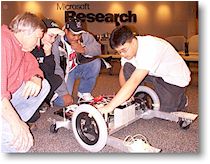REDMOND, Wash., March 4, 2004 — Amid the overhead power cords, Craftsman tools, and computer-controlled machine-shop equipment in the Microsoft Research (MSR) Hardware lab, Mike Sinclair inspects the handiwork of 16-year-old Isaac Liu.

Inspecting their Xbot contest entry: Microsoft’s Mike Sinclair (L) and Seattle students Charles Stanton, Jamal Harris, Ryan Lew.
“Nice. This is really well done, Isaac. It should do the job,” says Sinclair, a senior researcher in MSR’s Hardware Devices Group, examining the quick-disconnect battery holder Liu designed and built from scrap aluminum.
Liu, one of 20 teen-aged students from a pair of Seattle, Washington high schools working with Microsoft mentors to prepare for the 13th annual For Inspiration and Recognition of Science and Technology (FIRST) Robotics Competition, accepts Sinclair’s praise with a quick smile. Just as quickly, he is off to install the part.
This is Liu’s third year of FIRST competition, so he knows time is precious for the Microsoft “Xbot” team. The Northwest regional competition occurs today through March 6 in Portland, Ore., and the national competition will be held April 15-17 in Atlanta.
Founded by Dean Kamen, inventor of the Segway Human Transporter, the FIRST Robotics Competition gives teams six weeks to take parts ranging from a radio and batteries to car-window motors and turn them into a drivable robot capable of accomplishing a series of tasks.
“It’s not like an Erector Set,” Sinclair explains. “There are no directions. There are basic parts, and the kids have to use whatever materials they have available to build out the robot.”
Corporations help by mentoring students and providing financial support. This year, Microsoft donated copies of Visual Studio .NET, FrontPage, and Visio to all 1,000 teams participating.
Beyond the competition itself, the Microsoft mentors say they seek to instill confidence in their students and provide them with real-world application of the math and science skills they learn in school.
“Overcoming the confidence barrier has produced a great number of successes,” Sinclair says. “Very often, the group is surprised at a kid’s accomplishment, not because of the lack of skills, but because the kid had the others convinced he or she couldn’t succeed.”
Mentors and students collaborate on the design, building, and testing of the robot. This year’s design for the chassis — the platform that drives around — is a result of that process. Learning from the previous year’s mistakes, the mentors proposed various wheel and steering configurations.
“The kids worked through the advantages and disadvantages of each design,” Sinclair says, “gave their input, voted, and that’s what we’re implementing today.”
Mentor Ben Leclerc, a Microsoft software development engineer who works on Microsoft Exchange, learned enough about computers and manufacturing from participating in the FIRST competition while attending high school in Hudson, N.H., to land a part-time job that paid for his college education.
“Being able to pass on all the knowledge I learned from my high school experience with FIRST has been just as rewarding,” Leclerc says, “as when I was participating in the program as a student.”
Students who are less interested in building the robot can perform tasks such as programming, animation, building a Web site for the project, public relations, and fund-raising to help pay for travel, competition fees, robot parts, and other expenses.
Mentors Raj Ramachandran and Neal Shah, who are financial analysts for the Microsoft Business Solutions group, try to involve students as much as possible in their fund-raising and administrative efforts.
When the team needed T-shirts to wear for the competition, Ramachandran worked with his students to design the shirt using Microsoft PowerPoint and to find T-shirt vendors and prices over the Internet.
For Leclerc, seeing one youth find something to contribute to the competition makes his effort worthwhile.
“When you put some of these kids in front of machines,” he says, “they realize the power they have to create.”




